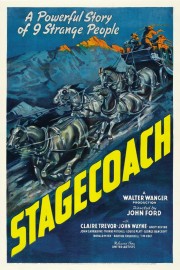Stagecoach
Watching John Ford’s “Stagecoach” for the first time, my mind couldn’t help but go to modern action movies. The simple premise of “Stagecoach” is this- a stagecoach, filled with a cross-section of different characters, trying to make their way across Apache territory without getting killed. The story Ford is telling is simple, and a scant 96 minutes long, and in its structure lies a formula that others have exploited many times over the years. The example that stands out most to me is that of Jan De Bont’s “Speed,” also about passengers caught in a dangerous trip via public transportation. Of course, that was not of their making; the characters in “Stagecoach” understand the risks involved with their journey.
This was the first of the long collaborative history that Ford would have with John Wayne, and it’s quite a beginning for the pairing. Wayne was Ford’s hand-picked choice to play the Ringo Kid, an outlaw being taken in to prison, and the former stuntman was an ideal choice for the role. It’s impossible to imagine another actor in the role after all these years, and it’s easy to see why Ford was so taken by Wayne, and insistent that he play the role. Wayne has a lot of the same traits as an on-screen performer as most of the action stars of the ’80s- your Arnolds, Slys and Fords- in that they have a natural swagger and presence about them on-screen that masks a relatively simple acting style. None of these people could ever be called great actors, but they were great at inhabiting the right roles, and that’s what John Ford, a genuinely great director, did so well with Wayne throughout their career together. He didn’t pigeonhole Wayne into playing the same character, either, as you can see in “She Wore a Yellow Ribbon,” “The Quiet Man” and “The Searchers,” and many other films I have yet to watch myself. Wayne isn’t playing the same character, but he gives off the same natural traits he showed in “Stagecoach,” and it is to Ford’s great credit that Wayne was able to find ways, time and again, to enhance those traits and make them work for his films.
If I’m not spending a lot of time on the story of “Stagecoach,” it is not intended as a slight to writers Ernest Haycox, who wrote the original story, or Dudley Nichols, who wrote the screenplay. Their story is a simple one, but it unfolds in a very natural, novelistic manner that Ford transmutes into action very well. Despite my earlier comparison of the film with respect to modern action movies, though, there’s not a lot of real action in the film- the Apache attack takes place in the last third of the film, and isn’t even the entire climax of the film- and much of the film’s focus is on the characters making the trip. We have Andy Devine as the stagecoach driver, John Carradine as a gambler, Thomas Mitchell as an alcoholic doctor, Louise Platt as a pregnant wife trying to get to her soldier husband, a traveling salesman played by Donald Meek, a prostitute played by Claire Trevor, and the Ringo Kid. The stagecoach hardly seems big enough to house all of these characters, but Ford doesn’t make us feel the claustrophobic nature of the setting, but lets each character have their own space. The film’s story is about the trip they are making together, but the focus is on the characters, and how they interact with one another, and how bonds form between them. This part is what really reminded me of “Speed” earlier, because one of the strongest parts of that movie was how De Bont, his writers, and his actors all gave character to the individuals on the bus to allow us to care about what they were going through. Ford does that here, and he gives us a set of characters we care about, and are intrigued by, every step of the way.










